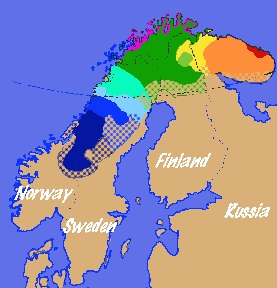Difference between revisions of "About Lule Sami"
| Line 10: | Line 10: | ||
'''SAAMI PEOPLE''' | '''SAAMI PEOPLE''' | ||
| − | + | Saami has been spoken on the Scandinavian and Kola Peninsulas in Northwest Europe since prehistoric times. Recent genetic, archeological and linguistic research suggests that the Saami people are descendent of the first inhabitants of the area after the glaciers of the last ice-age receded. | |
| + | Linguists currently recognize 9 living Saami languages. Lule Saami is the second largest of these. It is spoken by about 1,500 people. The traditional Lule Saami area runs from Luleå in Sweden on the Gulf of Bothnia to Nordland in Norway. This is shown on the following map. Note that the Sea Saami no longer have an independent language, but have adopted North Saami, Lule Saami or Norwegian. | ||
| − | + | Archeological evidence shows that Sábme/Sápmi extends along most of the western coast of the Gulf of Bothnia and reaches as far south as Hudiksvall - about 300 km north of Stockholm. This is shown here, but not on most modern maps for political reasons. The Saami also lived farther east and south in Finland than is shown here. | |
| − | + | The Saami languages belong to the Uralic language family and are unrelated to most of the other languages in Western Europe. The closest relatives are Finnish and Estonian, but the Saami languages separated from these more than 3,000 years ago. This means that the Saami language group has an independent history that is at least as long as the Germanic language group (e.g. German, English, Dutch, Norwegian, Swedish and Danish) and is twice as old as the Romance language group (e.g. Italian, French, Spanish, Portuguese and Romanian). This long history and the fact that they are usually not mutually intelligible makes them different languages, not different dialects as they are often mistakenly described. | |
| + | |||
| + | Although the Saami languages are classified as Finno-Ugric, their vocabularies are heavily influenced by contact with Slavic and Germanic neighbors. In addition, recent research suggests that they also contain remnants of the original Paleolithic languages of Scandinavia. | ||
| + | |||
| + | Because of its long independent history and the relatively few number of speakers (i.e. less than 30,000 total), the Saami language family is arguable the most endangered language family in Europe (UNESCO Redbook of Endangered Languages). | ||
Revision as of 21:39, 24 September 2008
Annotating and documenting Lule Saami is a NTNU pilotstudy using the TypeCraft database. Here we will soon tell you more about which texts we have chosen for linguistic annotation and why, and we will show you examples of our annotations, and tell you why we think it is important to annotate Lule Saami text. We also would like to tell you about our ideas of community-oriented language documentation, and not least, we would like you to get to know more about the Lule Saami people.
You probably already know that the Saami are an indigenous people living in Norway, Sweden, Finland and Russia, and that their territory stretches from the Kola peninsula in northwestern Russia to Engerdal in southern Norway and Idre in southern Sweden. This area is called Sápmi in the Northern Saami language. Traditionally, the Saami have lived by reindeer herding, fishing, hunting and farming, but today, the Saami have both traditional and modern jobs. There are many interesting sites about Saami and the Saami people that you can visit online: Lule Saami online
SAAMI PEOPLE
Saami has been spoken on the Scandinavian and Kola Peninsulas in Northwest Europe since prehistoric times. Recent genetic, archeological and linguistic research suggests that the Saami people are descendent of the first inhabitants of the area after the glaciers of the last ice-age receded.
Linguists currently recognize 9 living Saami languages. Lule Saami is the second largest of these. It is spoken by about 1,500 people. The traditional Lule Saami area runs from Luleå in Sweden on the Gulf of Bothnia to Nordland in Norway. This is shown on the following map. Note that the Sea Saami no longer have an independent language, but have adopted North Saami, Lule Saami or Norwegian.
Archeological evidence shows that Sábme/Sápmi extends along most of the western coast of the Gulf of Bothnia and reaches as far south as Hudiksvall - about 300 km north of Stockholm. This is shown here, but not on most modern maps for political reasons. The Saami also lived farther east and south in Finland than is shown here.
The Saami languages belong to the Uralic language family and are unrelated to most of the other languages in Western Europe. The closest relatives are Finnish and Estonian, but the Saami languages separated from these more than 3,000 years ago. This means that the Saami language group has an independent history that is at least as long as the Germanic language group (e.g. German, English, Dutch, Norwegian, Swedish and Danish) and is twice as old as the Romance language group (e.g. Italian, French, Spanish, Portuguese and Romanian). This long history and the fact that they are usually not mutually intelligible makes them different languages, not different dialects as they are often mistakenly described.
Although the Saami languages are classified as Finno-Ugric, their vocabularies are heavily influenced by contact with Slavic and Germanic neighbors. In addition, recent research suggests that they also contain remnants of the original Paleolithic languages of Scandinavia.
Because of its long independent history and the relatively few number of speakers (i.e. less than 30,000 total), the Saami language family is arguable the most endangered language family in Europe (UNESCO Redbook of Endangered Languages).

